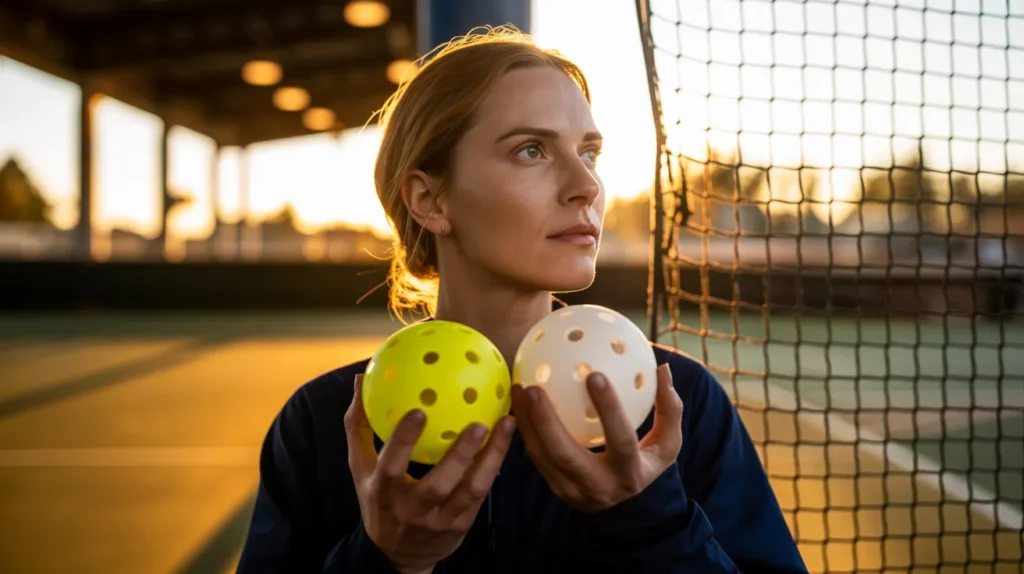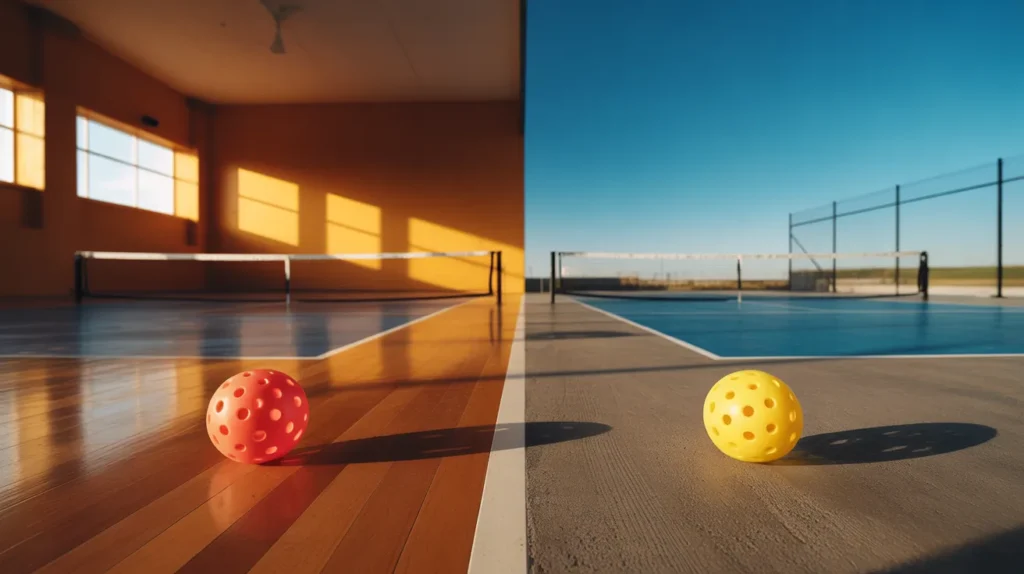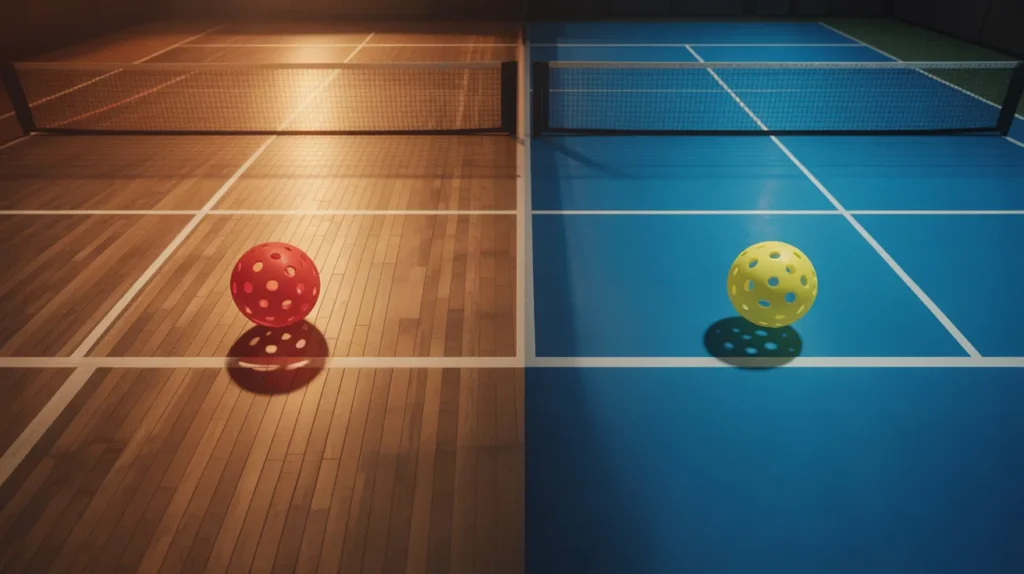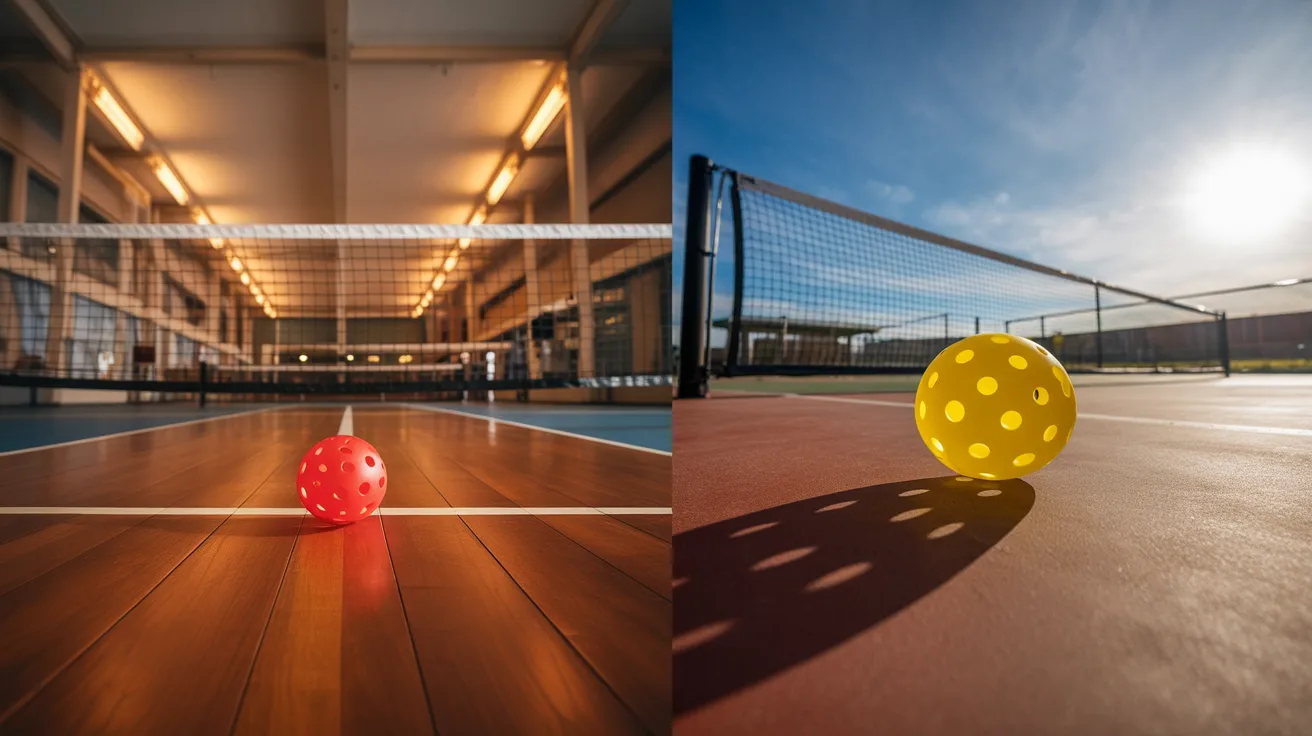Why the Ball You Choose Changes Everything
Most players focus on their paddle, their stance, even their shoes — but few realize how much the ball dictates the flow of the game. The truth is, the difference between indoor and outdoor pickleballs is more than just a design tweak; it’s a complete shift in how your game feels, reacts, and sounds. Once you understand it, you’ll never pick up the wrong ball again. in our ‘The Ultimate Pickleball Ball Showdown: Indoor vs Outdoor Edition’, everything will be explained for you.
A Quick Look: What Really Sets Them Apart
Set an indoor ball beside an outdoor one, and you’ll notice the story before you even swing.
-
Hole Count: Indoor balls have 26 larger holes that catch the air, slowing flight and adding control. Outdoor balls use 40 smaller holes to slice through wind and stay stable.
-
Material: Indoor versions are crafted from softer, lighter plastic to quiet the bounce. Outdoor balls are denser and harder, built to survive asphalt, grit, and heat.
-
Color: Indoors, darker tones like red or blue pop under bright lights. Outdoors, visibility rules — think neon yellow and optic green.
-
Texture: Outdoor surfaces are rougher and quicker. Indoors, smoother shells mean more finesse and touch play.
They might look like twins, but their personalities couldn’t be more different.
Real-World Feel: How Each Ball Plays
🏠 Indoor Pickleballs — Control Over Chaos
Indoor pickleballs are the artists of the sport — quieter, more forgiving, and designed for precision. The larger holes create drag, giving the ball a slower, floating flight that rewards control and strategy. On gym floors, you’ll feel a satisfying softness — perfect for rallies, dinks, and those clever kitchen exchanges that make spectators smile.
The trade-off? That same softness means they wear faster. Indoor balls tend to warp or lose shape after weeks of heavy play, especially under cold air conditioning or humidity. But while they last, they deliver the kind of tactile feedback that makes you feel completely connected to your paddle.

🌤️ Outdoor Pickleballs — Speed, Power, and Grit
Outdoor pickleballs, by contrast, are built for battle. Their tougher shells create a crisp, lively bounce that thrives on drive shots and volleys. The extra holes cut cleanly through wind, keeping your trajectory true on rougher courts. They’re louder, faster, and meaner — a favorite for players who love the adrenaline of pace.
Of course, all that toughness comes at a cost. Outdoor balls crack in cold weather and lose grip as they scuff. Once the surface dulls, flight paths become unpredictable — a reminder that even the strongest gear eventually gives in to the elements.
Sound, Feel, and Spin: The Sensory Side of the Game
🎧 The Sound of Impact
There’s a world of difference between an indoor “thud” and an outdoor “pop.” Indoors, the sound is muted and controlled — like a heartbeat in rhythm. Outdoors, it’s sharp, resonant, and unmistakably competitive. That sound becomes part of the player’s feedback loop; it tells you how solidly you’ve struck the ball before your brain even registers the shot.
🖐 The Feel of Control
Indoor balls feel grippy and deliberate. They reward patience, finesse, and players who thrive on precision. Outdoor balls, on the other hand, feel quick and electric — made for fast reactions and aggressive strokes. One gives you poetry; the other, raw energy.
🔄 Spin and Surface
Because indoor balls are softer, they cling to the paddle a fraction longer — giving advanced players the chance to carve spin or shape shots more dramatically. Outdoor balls pop off instantly, ideal for flat drives and volleys but less forgiving if you misjudge timing.

Buyer’s Guide: Finding Your Perfect Pickleball Ball
🎯 Top Indoor Picks
-
Onix Fuse Indoor: Excellent balance of softness and control, dependable on any gym surface.
-
Jugs Indoor: Perfect for casual or beginner players — quieter, easy on the hands, and long-lasting.
-
Franklin X-26: The go-to for competitive indoor players; consistent bounce and true roll.
☀️ Best Outdoor Performers
-
Dura Fast 40: Tournament standard — lightning-fast, crisp, and used by the pros.
-
Franklin X-40: A fan favorite for its blend of control and durability in variable weather.
-
Core Outdoor 40: Designed for longevity under heat and wind.
🧠 Matching Skill Level
-
Beginners: Start indoors; slower balls help develop placement and control.
-
Intermediate: Mix environments to sharpen reaction time and adaptability.
-
Advanced/Pros: Train with outdoor balls — they’ll expose and refine your timing, speed, and endurance.
Care and Maintenance: Making Them Last
A few habits will save you time, money, and frustration:
-
Keep them out of extreme temperatures. Cold cracks plastic; heat warps it.
-
Rotate your stock. Every few sessions, swap in fresh balls for consistent bounce.
-
Clean occasionally. A mild soap rinse removes grit that shaves off micro-layers of plastic.
-
Inspect before every match. Even a tiny crack can change trajectory — and cost you points.
On average, outdoor balls last 10–20 games, while indoor ones often stretch to 30–50, depending on play intensity.
What the Pros Know
The pros don’t pick sides — they train with both.
-
Ben Johns, one of pickleball’s greats, uses indoor sessions to fine-tune spin and placement, then takes his precision outdoors to face unpredictable wind and surface conditions.
-
Many high-level players intentionally mix indoor and outdoor drills, building reflexes and resilience across different game speeds.
That adaptability isn’t just skill — it’s strategy.

FAQs: Your Pickleball Questions, Answered
Q: Can I use indoor balls outside?
You can, but expect a shorter life and a less predictable bounce. The softer shell isn’t built for asphalt.
Q: Are outdoor balls really louder?
Yes. Their harder plastic creates a sharp “pop” that travels — one reason noise ordinances sometimes restrict outdoor play hours.
Q: Do professionals use different balls than amateurs?
They use the same models, just fresher stock. Most pros stick to Dura Fast 40 outdoors and Franklin X-26 indoors.
Q: Which ball gives better spin?
Indoor balls, hands down. The softer texture gives your paddle more grip time.
If you now understand what we have discussed, it might be time to take a look at how easy it is to learn this great game. Take a look at our recent post: “Master Pickleball in 7 Steps: A Beginner’s Blueprint for Winning Fast“.

